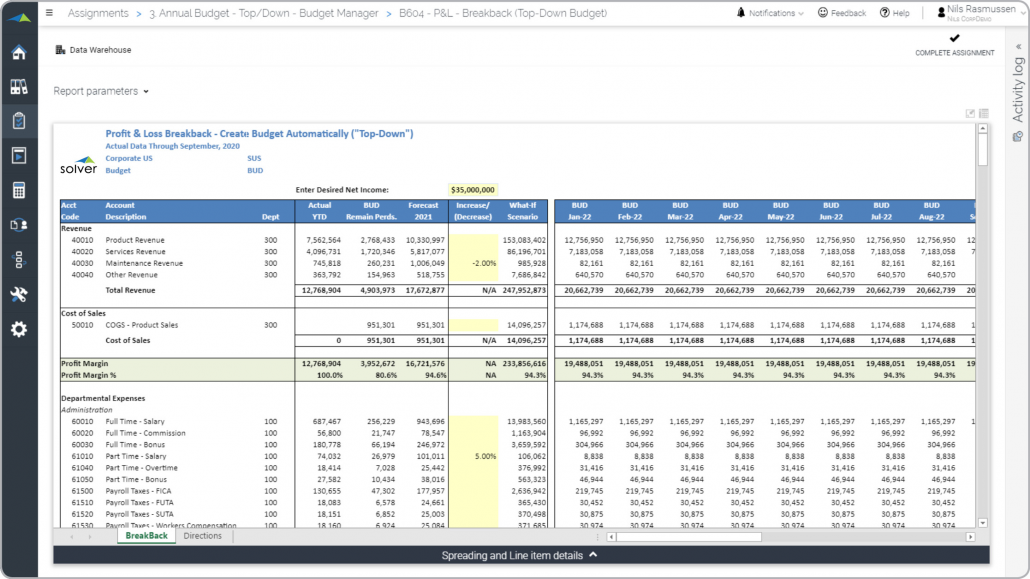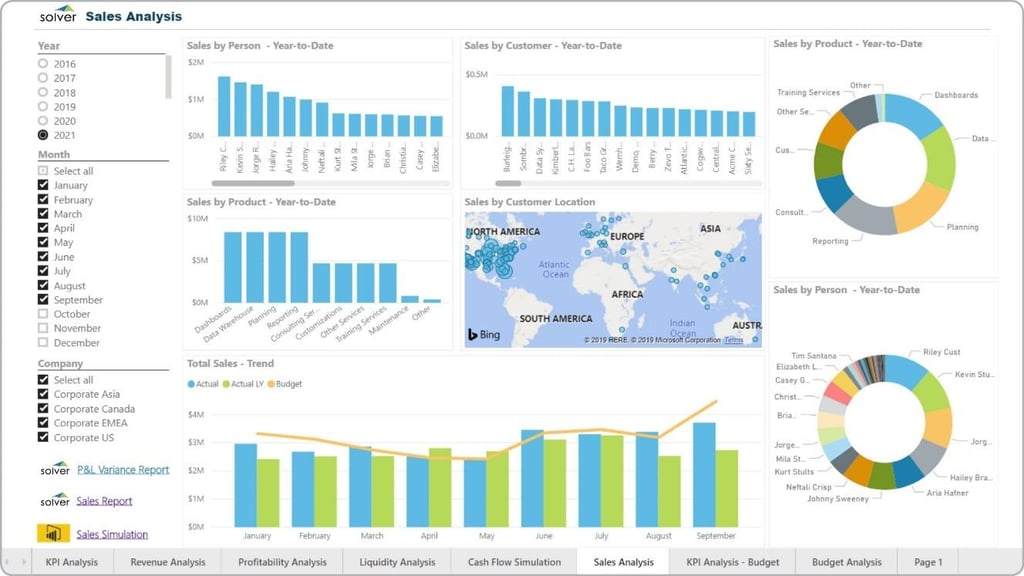Related Posts
- Better Reporting Leads to Better Business Decisions
- Advanced Planning Tools Foster Business Success
- xFP&A Software for Financial Consolidation Drives Intelligent Decisions
- Best Practices in Creating Consolidated Financial Statements
- Solver on Solver: ASCEND Data Insights Using Our Proprietary Reporting
How to Improve Budgeting, Planning and Forecasting

Are you dreading your company’s budgeting process? Are you manually exporting data from your ERP system to Excel and compiling numerous spreadsheets or are you manually formatting reports and presentations? Well, if that is you, there is hope for you! It does not have to be that way. There are solutions to improve your budgeting and reporting processes. This blog post will provide insight into some of the key features you could expect from modern corporate performance management (CPM) solutions.
A CPM solution is a specialized solution with the ultimate goal of helping a company make faster and better business decisions. This will guide your company on the path to receiving complete insight to your finances. Instead of carrying the burden of maintaining multiple report writers across several systems and a lack of enterprise-wide dashboards to visualize KPIs, a CPM solution like Solver offers advanced reporting, planning and dashboards across all systems including ERP systems, CRM systems, Google Analytics, and payroll systems to name a few.
Make Budgeting and Reporting Easy
As mentioned in a previous article about the Use of CPM Analytical Tools in the Budget Planning Process, a CPM solution facilitates a smooth and efficient budgeting and forecasting process across your organization. It also can help you save time and money by automating your financial and operational reporting. Streamlining your processes including assignments, workflows and approvals are much easier in a CPM solution than in a spreadsheet due to pre-built features specifically for these tasks.
Take Excel to the next level. Every company could needs a powerful and impactful financial reporting tool to speed up decisions to remain competitive in the industry. Report writers help companies analyze and manage their data without leaving any disruptions and faulty data. Given how popular Microsoft Excel is, it may be a shock that many people design their spreadsheets to manage critical business processes with very little to no audit and control features. This means that most spreadsheets have a poor foundation which leaves room for potential problems. Find a financial tool that offers the benefit of Excel-based reporting and form design including database-driven storage and cloud-based architecture to make budgeting and reporting much easier and simpler. Modern CPM solutions, like Solver, have powerful Excel report designer add-ins that connect to a cloud portal where all end users enter budgets and run reports in a browser environment with zero footprints on their local PC.
Budgeting can be a time-consuming process for many companies, but it is necessary to communicate the importance of a budget to the entire company and how it supports strategic goals. Every organization should find a solution that has customizable budgeting templates to help organize and deploy your budget according to specific industry best practices. For instance, advanced budgeting should include capital budgeting by asset, personnel budgeting by position, revenue budgeting by quantitative drivers, expense budgeting by detail, and user definable input forms, workflow and comments.
Analyze the Finished Budget with Dashboards
Most CPM solutions now offer modules that make it easier and faster to deploy and maintain your dashboards. The ideal solution provides a user-friendly, pre-configured cloud data warehouse that has various data connectors. Consolidating all of your data sources with a modern data warehouse makes it faster and easier to design dashboards and to analyze your data with powerful dashboard solutions like Microsoft’s Power BI. By combining a reporting tool like Solver with a leading analytics and dashboard tool like Power BI, you will get the best of CPM and BI.

Key functionalities that will help support optimal forecasting and budgeting:
Event-Driven Functionality
CPM Suites will increasingly offer automated modeling functionality so that managers quickly can provide forward-looking plans and scenarios that are event-driven. In other words, if there is a market crash, a company may quickly need to produce an updated cost reduction budget, or if a company is looking to acquire another business, they may need to analyze the cash flow impact and produce Pro-forma financial statements to executives to help them make optimal decisions.
Purpose-Driven
Other important functionality that will be better and easier in future CPM suites is the ability for smaller businesses or resource-strapped accounting departments to automatically create budgets or forecasts to be used, e.g. to get a line of credit at the bank or to set commission quotas for a sales team that are dynamically connected back to a budget scenario. This can eliminate the massive use of manual, non-integrated spreadsheets that exists today for special or departmentally-driven micro-planning processes such as the examples provided.
Strategy-Driven
While today, most organizations enter and store their strategic goals and initiatives outside their CPM tools, in Microsoft Word or PowerPoint, in the future they will be able to easily capture these in their CPM suite and thus fully integrate the related key metrics in forecasts, budgets and reports, thus ensuring that all users have constant visibility to strategy and goals for their decision-making processes. This is extremely valuable to a company because it helps ensure that decisions at all levels are aligned with the planned strategic direction of the organization. A survey published by the Harvard Business Review found that only 5% of employees understand the company’s strategy. It is easy to imagine the benefits to a company when the opposite is true, and this can be enabled by including such metrics and information within the CPM platform, so that strategy and goals are not forgotten and “lost” to employees, but instead are constantly visible and available to users to help guide their decision-making processes.
Automated Strategy Adjustments
Not only will CPM suites of the future be able to automatically integrate strategy and goals into a budget, but the reverse will also be true. For example, if there are changes in, e.g., funding requests because a department suddenly needs to hire 10 people not planned for due to a new product idea, a change in direction or a response to a competitive threat, a forecast due to any of the mentioned events may automatically drive a change to the related strategic goals.
Budget Planning Optimization
While preparing an organization-wide budget typically is an arduous process in itself, especially for bottom-up processes where a large number of people are involved in entering and reviewing budgets, it gets even more complicated when advanced business rules and constraints are involved. The actual planning process ends up becoming very complex and time-consuming as a result of numerous decision points that need to be evaluated concurrently, including market demand and funding availability. In future CPM suites, planning and analysis optimization techniques will more effectively translate business rules into mathematical formulas that can be used to create dynamic budgeting and forecasting scenarios. Furthermore, integrated algorithms will be able to solve those equations and provide the best budget allocation options among all possible scenarios and types of drivers, such as risk reduction, cash flow targets, and profitability goals.
Machine Learning and Automated Forecasting
According to Wikipedia, machine learning is “the subfield of computer science that gives computers the ability to learn without being explicitly programmed.” In recent times, there has been increasing interest in and development of algorithm-driven programs to automate the ability of software programs to perform all kinds of personal and business tasks. In the field of CPM, this includes forecasting future metrics based on historical data as well as current and estimated conditions, such as weather, inflationary risk, and more. The more variables you add to the mix, the harder it is for a human brain or basic spreadsheet models to figure out, and the better suited advanced algorithms that dynamically update and improve themselves are to perform tasks such as forecasting.
A practical example, often of critical importance to a business, is to forecast future inventory needs as accurately as possible. This is often referred to as predictive analytics and “real-time forecasting” because it can be almost instantly without the need to collect forecast data from end-users. Another example is in sales, where machine learning and algorithms can look at a large number of variables and patterns and figure out which customer is most likely to buy a specific product from you right now and thus should be prioritized by your sales team. This is typically referred to as prescriptive analytics.
Learn More About Budgeting, Forecasting & Modeling with Solver
CPM software can enable world-class decisions and help propel a company to the leading position in its industry. If you are struggling to find a CPM tool that fills in all of the blanks, Solver has a team of professionals that can get your company started.
TAGS: Reporting, Consolidation, Planning, Analysis, Budgeting, CPM, Events, ERP, FP&A, Dashboards, Partners, Financial Reporting, Compare CPM
Global Headquarters
Solver, Inc.
Phone: +1 (310) 691-5300
